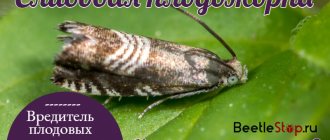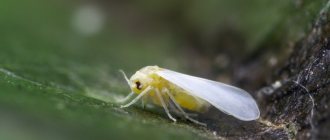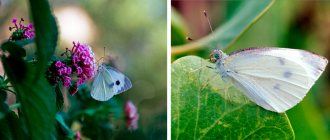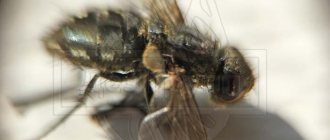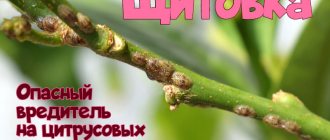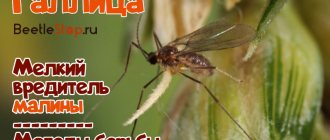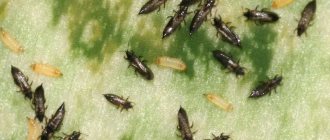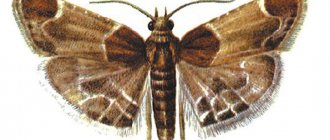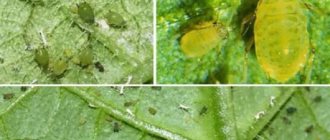Tobacco thrips is not only a major pest of tobacco - it also damages vegetable crops such as onions, cucumbers or potatoes. In addition, it transmits viral diseases, which makes this insect a very dangerous pest for crops.
Unfortunately, tobacco thrips are not the only type of thrips that are not averse to feasting on our harvest. For example, wheat thrips can cause great damage to cereal crops.
Who is tobacco thrips?
Tobacco thrips is a tiny insect that is a pest of tobacco, lily, pumpkin, melon and vegetable crops.
Thrips damages approximately 400 plant species and is distributed throughout almost the entire territory of Russia.
Description of the larva
The tobacco thrips larva resembles the adult, but without wings. Its color changes depending on the stage of maturation from white to yellow.
Description of the adult
An adult thrips has a narrow, oval body that is approximately 0.8–0.9 mm long. It has two pairs of narrow gray-yellow wings surrounded by fringe. Females and males have some differences.
The female can be either light yellow or dark, almost black, brown. It has a transverse head with small setae and a transverse prothorax. The forewings are slightly yellowish, and the lower legs and thighs are grey. The male is smaller than the female, approximately 0.1–0.3 mm. The antennae are darker, and the body, on the contrary, is lighter.
The tobacco thrips differs from other species of thrips in that it has four distal setae on the fore wings and an almost transparent first antennal segment.
Subspecies of tobacco thrips differ in body color. Dark ones are usually found in spring, and light ones in summer.
Traces of thrips on the site - how to detect the danger?
To understand that it’s time to fight thrips by choosing the right and effective methods, you need to detect their traces on crops. Given the small size of the pest, it is almost impossible to see it without a special inspection of the plants. In addition, thrips successfully camouflage themselves, hiding on the back side of the leaf without attracting attention.
The more insects have had time to breed, the easier it will be to detect them by signs of vital activity, deterioration of crops - openwork on the leaves, yellow pigmentation, black accumulations of excrement. A plant affected by an insect quickly weakens and, if no action is taken, dies.
Reproduction method
For the winter, females go into the soil or plant debris to a depth of 5–7 cm and emerge in mid- or late April, colonizing weeds. They lay eggs in the leaf tissue, about 100 eggs per
life. Fertility depends on the type of food plant and temperature. The most intensive development occurs in arid places.
Tobacco thrips is almost never found on young or aging leaves. Most of them are located on the formed ones. The larvae are found on the lower part of the leaf, less often on flowers or fruits.
The embryo develops from three days to a week, then passes through the larval stage for about 10 days. They go into the soil. And after about another week, adult insects rise to the surface.
Females and their offspring fly from weeds to crops and cause damage.
Prevent occurrence
Bulb plantings after thrips infection
- Onion thrips can be controlled by proper crop rotation. Repeated planting of bulbs is allowed in the same beds only after a four-year break.
- Regularly inspect plants for migrating thrips larvae. If they are detected, inspect the crops growing in the vicinity of the onion beds.
- There is no need for a greenhouse to plant cucumber seedlings and tomatoes with onions at an early stage.
- After harvesting, leave a clean garden in winter, removing and burning plant debris. The same is done with waste remaining in storage facilities after winter.
- Autumn digging of the soil to a depth of at least 0.15-0.25 m is required. This is due to the fact that the pest mainly overwinters at a depth of 7 cm.
- If onions are grown in greenhouses, after collecting the bulbs they are treated with Karbofos (15%).
- Weeding between rows in the summer, on the one hand, removes weeds, and on the other, destroys insect pupae.
- Before planting the affected seed, it is warmed up for 48 hours at a temperature of 40-42°C.
- You can immediately soak the bulbs in hot (50°C) water for 5 minutes before planting them in the ground and immediately dip them in cold water.
- Plantings of onions and other plants are regularly irrigated with water.
- If an insect has settled on an onion, you can wash it off with a stream of water under pressure.
- Mulching the soil will help maintain moisture.
Attention! Finding out whether there are thrips on onions is quite easy. You need to trudge the plant over a clean white sheet.
What harm does it cause to plants?
Tobacco thrips harms onions, cucumbers, zucchini, eggplant, melons, and sometimes cabbage, celery and parsley. Damage is caused by both larvae and adults.
Tobacco thrips sucks the juice from the leaves, which leads to moisture deficiency and the formation of yellow-brown spots. Petals and stamens are also damaged. When there is a high density of insects, the leaves curl, turn yellow and dry out completely. In addition, thrips can feed on the sap of flowers, causing them to fall off prematurely.
The striped click beetle larva is the most “voracious” stage of the insect’s life cycle. To get rid of the Swedish fly, you can use various control methods - both chemical and folk. You will find detailed information in this article.
Pea weevil larvae are about 6 mm in size. Read the full description of the insect at the link.
How to defeat thrips using traditional methods?
How effective is the fight against thrips on the site using folk remedies? This can be judged only after applying them in practice. In any case, a positive result can be achieved only at the initial stage of infection. So, thrips on peppers, onions, tomatoes, and potatoes can be destroyed using:
- steamed onion infusion with soap for greater effect;
- decoction of tobacco dust;
- decoctions of capsicum, celandine or yarrow.
In conclusion, we note that tobacco thrips is a serious test for a gardener. The insect multiplies quickly and infects crops, disrupting harvest plans. That is why it is so important not to neglect preventive measures and follow the recommendations of pest control specialists.
How to deal with the pest?
Consider the following pest control measures:
- agrotechnical,
- biological,
- chemical.
Agrotechnical methods
- ensuring high air humidity and uniform watering, since tobacco thrips mainly develops on those crops that grow in dry places;
- digging up the soil and eliminating post-harvest residues;
- weed control, as thrips reproduce and feed on them in the spring;
- placing onions as far as possible from other crops to prevent them from being colonized by tobacco thrips, since it is onions that are most often damaged by this pest.
Biological methods
- Predatory phytoseiid mites (Neoseyulus) effectively fight thrips larvae. The application rate is 300–500 females per plant. They are bred on wheat bran and fed with cancer mites;
- orius bugs and anthocoris bugs.
Chemicals
Insecticides are applied at weekly intervals. Cannot be used on onions grown for greens. The following remedies are effective:
- "Aktara", VDG (400 g/ha);
- "Karate Zeon", MKS (150–200 ml/ha);
- “Fufanon” (1 ampoule per 1 liter of water);
- "Commander Maxi" (3 g/ha);
- "Iskra Zolotaya" (10 ml/ha).
You can also use an infusion of onion peels - 4 liters of water per 2 liters of peels, after two days add another 12 liters of water and add laundry soap. Before storing the bulbs, they should be treated with sulfur gas (50 g of sulfur is used per 1 m3 of room).
The use of these methods (separately or in combination) will help rid tobacco and vegetable crops of tobacco thrips, and the use of uninfected planting materials will reduce the risk of its occurrence in the future.
What methods will help get rid of thrips on the site?
If prevention does not produce results, thrips appear on onions - everyone can decide for themselves how to deal with insects individually after analyzing the available methods. You can get rid of insects in a vegetable plot using the following methods:
- Agrotechnical.
- Chemical.
- Biological.
- People's
It is believed that tobacco thrips develops on onions more often and faster than on other crops. That is why you should be especially careful when planting onions, keeping a distance between them and other crops on the site.
If the plant does become infected, it is worth rinsing the affected areas under high pressure water.
Chemical methods include the use of insecticides - drugs against pests. These include:
- Actellik.
- Vertimek.
- Agravertine.
- Confidor Extra.
- Karate.
- Smoke bomb "Climate".
For example, thrips on cucumbers can be exterminated by Actellik. The drug is added to water (1 ampoule per 2 liters), after which it is poured into a container with a sprayer and used to treat affected plants. The procedure must be carried out in weather without wind, covering the plants after treatment for a day with plastic wrap.
To defeat thrips on seedlings, Vertimek can be used. The consumption of the drug is small (2.5 ml per 10 liters). After treatment, the seedlings are also covered with film for a day.
The preparations Karate and Agrevertin give a good effect, but only if the rules of preparation and use prescribed in the instructions are followed. The most resistant to precipitation is Confidor Extra. It is diluted in a liter of water (2 ml ampoule), treated areas between rows, and also added to fertilizers.
A smoke bomb is used to treat the room where the crop will be stored at least 7 days before planting. After using the product, keep the room closed for 30 hours and only then ventilate.
In order not to cause the thrips to become addictive, you need to treat onions, tomatoes and other crops by alternating medications and repeating the procedure every week for a month. This is important in order to neutralize the insect at each stage of development.
Having discovered onion thrips (the photo will help you avoid mistakes) on the site, you can try to apply biological methods to it, for example, baiting the predator - the Phytoseilus mite. Antokoris and Orius bugs can also help in the matter of exterminating pests.
Plants that secrete phytoncides to attract entomophages
There are plants that, when grown in your own area, help create an environment favorable for beneficial insects.
It should be noted that many of these herbs not only attract entomophagous insects, but also repel certain pests. Thus, having these plants on your site, you can, as they say, kill two birds with one stone and completely abandon the use of pesticides and pesticides.
Some garden crops are also capable of attracting beneficial insects, for example, legumes (vetch, clover). The latter not only, as noted earlier, enrich the soil with nitrogen, but also provide entomophages with moisture and food.
In order for herbs that attract entomophages to bloom in the area throughout the season, first of all you need to plant those plants that bloom earlier. For example, you can first plant buckwheat and then dill in one bed. It is better to sow marigolds and calendula as early as possible so that they bloom in mid-summer. Another option is to simply plant herbs in one place that bloom for a long time (clover, tansy, navel).
Plants that protect against pests, which serve to attract entomophages and provide the opportunity to maintain a natural balance between the number of unwanted and beneficial insects, include the following.
Lemon marigolds.
This plant attracts spiders and small wasps. It is best to grow marigolds using seedlings. Marigold seedlings are planted in the ground after frost has passed.
Buckwheat.
This is a honey plant that attracts ladybugs, bees, hoverflies, predatory bugs, and flies to the site. Buckwheat is an effective soil-forming plant that increases the content of organic matter in the soil.
Sweet clover officinalis.
It is a biennial plant, a good honey plant, and has small yellow flowers. The aroma of sweet clover attracts many beneficial insects, including pollinators. In addition, sweet clover is a soil improver.
Spearmint.
Spearmint attracts spiders and flies. It is a herbaceous perennial plant with lance-shaped bright green leaves, creeping roots and pink or purple cone-shaped flowers.
Common tansy.
It is capable of attracting predatory bugs, ladybugs, lacewings, parasitic wasps, as well as flies to the site, since this plant is an excellent source of their nutrition. Tansy is known to repel pests such as the Colorado potato beetle.
Dying navel.
This plant is perennial and attractive to flies and wasps. During flowering, it is covered with small yellow flowers, shaped like calendula flowers. A distinctive feature of the plant is the characteristic aroma emanating from it.
Reasons for appearance on indoor plants
The invasion of pests is associated with conditions that include convenient routes of entry and an environment favorable for their habitat.
You should pay attention to the following factors:
- First of all, parasites enter a room through a window. This is their most “trodden path”. Especially if there are trees or other plantings near the house. Thanks to their wings, they move long distances and can enter an apartment with a gust of wind from a neighboring home, through an open door or window.
- There are frequent cases of infection of other flowerpots after purchasing an already infected greenhouse plant. Therefore, there is an unspoken rule: new flowers in pots are never placed immediately next to others, but are first kept in quarantine for a week.
- A fragrant bouquet of graceful representatives of the field, garden or greenhouse flora can also become a source of thrips in the house.
Only the last two factors depend on the individual, and he can provide prevention. It is worth remembering that any new plants, regardless of their type and original habitat, can cause a pest invasion.
Precautionary measures
Despite the fact that tobacco infusion against pests is non-toxic, you should adhere to some safety measures
Since careless use can cause health problems, you must:
- wear a cotton-gauze bandage to protect the respiratory tract;
- rubber gloves are used to protect the skin of the hands;
- eye protection glasses;
- If the drug gets on the skin and mucous membranes of the eyes or mouth, rinse thoroughly under running water.
- while carrying out work to get rid of pests, you must not smoke, drink or eat food;
- at the end of the procedure, wash your hands and face well with soap;
- Children, pregnant and lactating women, as well as people with allergies are not allowed to work with the infusion;
- preparations of dried raw materials for the drug must be done with gloves and scissors;
- store the prepared raw materials with signed labels, because not only fresh tobacco is used to make the infusion, but also dried tobacco;
- The dishes used for making the infusion must be washed with a solution of soda ash or wood ash, and then rinsed with plain water.
Thanks to tobacco infusion, you can get rid of almost any harmful insect for home crops
It is important that this method is not only effective, but also economical
Prevention
If you do not buy soil for planting flowers in a store, but dig it yourself, for example, from the same garden, it must be disinfected; to do this, treat it with such agents as “Antonem-F” or “Nemabakt”. Do not forget that plants need to be watered periodically so that the soil does not stand dry, and also carry out loosening.
Purchased flowers or those brought from the garden can also be carriers of these pests, so place them away from indoor plants.
To repel parasites from plants both in the garden and in the apartment, you can use strong-smelling flowers. For home flowers, you can prepare an infusion from plants such as celandine, marigold, and tobacco. And in the area in the garden where you notice the appearance of these insects, simply plant the same plants; they will help not only in the fight against thrips, but also with many other pests, for example, ants.
Onion hoverfly
Bronze-green, with light gray stripes on its back, the onion hoverfly literally steps on the heels of its predecessor, the onion fly, trying to snatch primacy among onion pests from its thin legs. This small insect (up to 9 mm) spoils not only onion plantings in the beds, but also forced onions standing on your window
An extremely harmful individual, isn't it? Therefore, it is important to notice it in time: the first sign is yellowing onion leaves. The sad outcome is rotting of the bulbs
The onion hoverfly's flight begins with the beginning of rosehip flowering.
Measures to combat onion hoverfly
Experienced gardeners carry out a number of activities that help eliminate the onion hoverfly. They know for sure that it is not at all necessary to immediately grab onto “chemistry” - first you need to use “folk” means of struggle.
- carry out autumn digging, thereby destroying the pest larvae;
- pre-soak the planting material in a solution of potassium permanganate (this will destroy the pest larvae that may be in the seedlings);
- plant carrots next to the onions (it will repel not only the onion fly, but also the onion hoverfly);
- observe crop rotation, maintaining a break of 3-4 years before returning the onions to their original place;
- Early planting of onions can also provide protection against pest attacks;
- to repel the onion hoverfly, pollinate the plantings every week with lime, mothballs, ash, tobacco dust or ground pepper;
- mulch the beds with chopped spruce branches, rotted manure and peat.
To speed up the growth of onions and reduce the likelihood of damage to the plantings by the onion hoverfly, use 3 liters of urea solution per 1 sq.m of bed (1 tbsp urea per 10 liters of water).
Preventive measures
Simple steps that need to be performed regularly will help you avoid infection. These measures are universal (suitable for garden, garden, and home plants):
- daily thorough inspection of all parts;
- timely removal of dust, organic residues, fallen leaves and flowers;
- control the level of humidity (avoid drying out, especially in winter).
Thrips are a small pest that poses a threat to any plants. Indoor flowers, seasonal crops, garden trees - the parasite settles on any of them. Thrips feed on cell sap and carry dangerous diseases. In the absence of timely assistance, the infected plant dies. With “massive” populations of thrips, the entire crop or the entire collection of indoor flowers is at risk.
Other methods
Another way to deal with thrips is to place sticky traps between the beds. The base is paper tapes and cardboards, painted in colors “attractive” to insects – yellow or blue. Coated with glue to catch flies and other insects. Thrips caught in the trap will allow us to assess the real picture of the population size, as well as significantly reduce it.
To prevent this condition of the bed, it is necessary to apply preventive measures
Using folk remedies, you can treat onions with infusions of herbs and flowers. But these are rather deterrent measures that are practically ineffective when there is a large dominance of pests.
- Leave 1 tablespoon of chopped onion or garlic in a glass of water for 24 hours. Sprinkle the strained stock onto the culture.
- Grind dry tobacco leaves. A little water is poured. The composition is aged for 3 hours, filtered and infused for 36 hours. The strained concentrate is diluted with water 1:2 before spraying.
- Grind 200 g of dried lemon, pomegranate, tangerine and orange peels along with 80 grams of yarrow, 10 g of hot red pepper and 2 cloves of garlic. You can also add wood ash. The mixture poured with boiling water simmers over low heat for a quarter of an hour. Leave until the mixture cools down and strain.
- Use freshly picked celandine stems and flowers (400 g). Instead of fresh raw materials, dry grass (100 g) is used. Celandine is filled with water in an amount of 1 liter and infused for 48-72 hours.
Attention! Predatory mites Amblyseius degenerans, Amblyseius barken and predatory bugs Orius majusculus are also destroyers of thrips larvae. To get rid of them, it is enough to release 300 females for one infected plant. Statistics show that the effect of using entomopathogenic nematodes when applied to the soil gives an almost absolute result.
Using all of these methods or some of them will give good results in reducing the thrips population. Planting disinfected material will reduce the likelihood of future pest occurrences.
Check out articles on similar topics
- Ways to combat onion fly
- Fighting with an onion sneaker
- Root mite on onions
- Damage and harm from onion hoverfly
Comments
leave a comment
